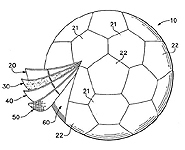The Football (Soccer Ball)
1. Main components of a football (soccer ball)
If you cut a conventional football in two, you will find that things do not seem to have changed significantly since the early days: a football consists of two main parts, an outer casing and a rubber bladder.
If you inspect these two main components more closely, you will discover a large variety of details regarding materials used and processing techniques. You will understand their significance only if you are familiar with the materials and their properties.
The casing consists, as a rule, of several layers of synthetic material and is composed of a an outer cover of polygonal panels, and a rubber foam, a latex and a textile layer. These layers are bonded together and secured on the rubber bladder. Why is this multi-layer design preferred? What properties do the individual layers present, and what is the purpose of each individual layer incorporated in a football?
Even conventional parts such as the valve or the nozzle required for inflating the bladder were subject to many changes in the past.
The following chapters will give on overview on the development of the components of a football in modern times.
US Patent application 2004 / 0 213 984 A1 (Figure 1) shows the typical modern design of a game ball which incorporates many of the above-mentioned elements.
| Publication number | Year | Title | Brief description |
|---|---|---|---|
| US 2004/0 213 984 A1 | 2004 | Game ball incorporating a polymer foam | Laminated football with multi-layer outer casing |

